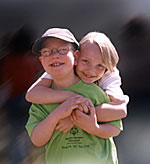Principal investigator: Ronald J. Iannotti, Ph.D.
The Health Behavior in School-Aged Children (HBSC) project, a World Health Organization cross-national study, is a unique quadrennial research study of adolescent health, health behaviors, and the family, school, and social-environmental contexts for these health behaviors. The international HBSC survey is conducted with national and regional samples of students ages 11, 13, and 15 years in more than 40 countries.
The HBSC survey instrument is an international standard questionnaire used by all participating countries. Researchers in the United States administered the instrument in 1997-1998, 2001-2002, and 2005-2006; they are scheduled to administer the instrument again in 2009-2010. The NICHD project includes an extended national instrument, which includes a larger national sample of youth in grades 6 through 10, and an over-sampling of minority youth to permit more accurate population estimates.
The goal of the HBSC survey is to obtain data about adolescent health behavior and to make this information available so as to enable the improvement of health services and programs for youth. The international standard questionnaire facilitates the collection of common data across all participating countries and, thus, enables the quantification of patterns of key health behaviors, health indicators, and contextual variables. These data allow cross-national comparisons and, with successive surveys, trend analyses at both the national and cross-national level.
DESPR Collaborators
· Bruce Simons-Morton, Ed.D., M.P.H.
· Denise L. Haynie, Ph.D., M.P.H.
· Tilda Farhat, Ph.D, M.P.H.
· Jing Wang Ph.D.
Selected Publications
Pickett W, Simons-Morton B, Dostaler S, & Iannotti RJ. (In press). Social environments and physical aggression among 21,107 students in the United States and Canada. Journal of School Health.
Zaborskis A, Petronyte G, Sumskas L, Kuzman M, & Iannotti RJ. (2008). Body image and weight control among adolescents in Lithuania, Croatia, and the United States in the context of global obesity. Croatian Medical Journal, 49(2):233-242. [Abstract]
Spriggs AL, Iannotti RJ, Nansel TR, & Haynie DL. (2007). Adolescent bullying involvement and perceived family, peer and school relations: Commonalities and differences across race/ethnicity. Journal of Adolescent Health, 41(3):283-93. [Abstract]
Due P, Holstein BE, Lynch J, Diderichsen F, Gabhain SN, Scheidt P, Currie C, and the HBSC Bullying Working Group. (2005). Bullying and symptoms among school-aged children: International comparative cross sectional study in 28 countries. European Journal of Public Health, 15(2):128-132. [Abstract]
Gage JC, Overpeck MD, Nansel TR, & Kogan MD. (2005). Peer activity in the evenings and participation in aggressive and problem behaviors. Journal of Adolescent Health, 37:7-14. [Abstract]
Nansel TR, Craig W, Overpeck MD, et al. (2004) Cross-national consistency in the relationship between bullying behaviors and psychosocial adjustment.. Arch Pediatr Adolesc Med, 158:730-736. [Abstract]
Saluja G, Iachan R, Scheidt PC, Overpeck MD, Sun W, & Giedd JN. (2004). Prevalence of and risk factors for depressive symptoms among young adolescents. Arch Pediatr Adolesc Med, 158:760-765. [Abstract]
